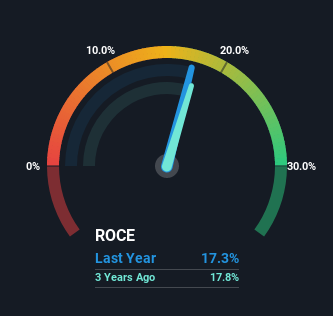
If we want to find a stock that could multiply over the long term, what are the underlying trends we should look for? Firstly, we'll want to see a proven return on capital employed (ROCE) that is increasing, and secondly, an expanding base of capital employed. This shows us that it's a compounding machine, able to continually reinvest its earnings back into the business and generate higher returns. However, after investigating Aries Agro (NSE:ARIES), we don't think it's current trends fit the mold of a multi-bagger.
Return On Capital Employed (ROCE): What is it?
For those who don't know, ROCE is a measure of a company's yearly pre-tax profit (its return), relative to the capital employed in the business. To calculate this metric for Aries Agro, this is the formula:
Return on Capital Employed = Earnings Before Interest and Tax (EBIT) ÷ (Total Assets - Current Liabilities)
0.17 = ₹448m ÷ (₹5.1b - ₹2.5b) (Based on the trailing twelve months to March 2022).
Thus, Aries Agro has an ROCE of 17%. By itself that's a normal return on capital and it's in line with the industry's average returns of 17%.
See our latest analysis for Aries Agro

Historical performance is a great place to start when researching a stock so above you can see the gauge for Aries Agro's ROCE against it's prior returns. If you want to delve into the historical earnings, revenue and cash flow of Aries Agro, check out these free graphs here.
What The Trend Of ROCE Can Tell Us
Things have been pretty stable at Aries Agro, with its capital employed and returns on that capital staying somewhat the same for the last five years. This tells us the company isn't reinvesting in itself, so it's plausible that it's past the growth phase. With that in mind, unless investment picks up again in the future, we wouldn't expect Aries Agro to be a multi-bagger going forward.
On a separate but related note, it's important to know that Aries Agro has a current liabilities to total assets ratio of 49%, which we'd consider pretty high. This effectively means that suppliers (or short-term creditors) are funding a large portion of the business, so just be aware that this can introduce some elements of risk. Ideally we'd like to see this reduce as that would mean fewer obligations bearing risks.
The Bottom Line
We can conclude that in regards to Aries Agro's returns on capital employed and the trends, there isn't much change to report on. Since the stock has declined 11% over the last five years, investors may not be too optimistic on this trend improving either. On the whole, we aren't too inspired by the underlying trends and we think there may be better chances of finding a multi-bagger elsewhere.
One final note, you should learn about the 5 warning signs we've spotted with Aries Agro (including 1 which can't be ignored) .
For those who like to invest in solid companies, check out this free list of companies with solid balance sheets and high returns on equity.
New: Manage All Your Stock Portfolios in One Place
We've created the ultimate portfolio companion for stock investors, and it's free.
• Connect an unlimited number of Portfolios and see your total in one currency
• Be alerted to new Warning Signs or Risks via email or mobile
• Track the Fair Value of your stocks
Have feedback on this article? Concerned about the content? Get in touch with us directly. Alternatively, email editorial-team (at) simplywallst.com.
This article by Simply Wall St is general in nature. We provide commentary based on historical data and analyst forecasts only using an unbiased methodology and our articles are not intended to be financial advice. It does not constitute a recommendation to buy or sell any stock, and does not take account of your objectives, or your financial situation. We aim to bring you long-term focused analysis driven by fundamental data. Note that our analysis may not factor in the latest price-sensitive company announcements or qualitative material. Simply Wall St has no position in any stocks mentioned.
About NSEI:ARIES
Aries Agro
Engages in the manufacture and supply of micronutrients and other nutritional products for plants and animals in India, Nepal, Brazil, the Netherlands, the United Arab Emirates, Taiwan, Australia, Turkey, New Zealand, and internationally.
Solid track record with excellent balance sheet.
Similar Companies
Market Insights
Community Narratives



